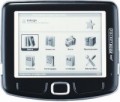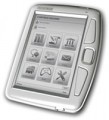E-book formats
File formats supported by the reader that contain text (and sometimes graphic information). The most popular in the CIS are, in particular,
FB2,
TXT,
HTML,
WORD (DOC),
RTF,
ePUB,
Djvu and
PDF.
RAM
The amount of the reader's own RAM, that is, the memory used for temporary data storage during operation. The speed of the e-book directly depends on the amount of RAM, especially when working with large files. So the average value can be considered
RAM 1 GB and
2 GB, and more advanced models have
3 GB,
4 GB and even
6 GB of memory.
Storage capacity
The amount of the reader's own built-in memory, i.e. the memory used for persistent data storage. The more memory, the more content can be stored at a time in the e-book. At the same time, note that even the largest text (TXT, FB2, HTML) files, usually, rarely exceed 2 – 3 MB, so relatively little memory is needed for storage. Graphic and audio files, in turn, are more voluminous, but most of the space is needed for video files. Therefore, depending on the use of the gadget, you will need a different volume, whether it be
4 GB, 8 GB or more. Many readers support the ability to expand their own memory through removable cards (see
Memory card slot).
Data transfer
—
Wi-Fi. A wireless communication module that allows you to connect the reader to wireless local (home or office) networks, as well as access the Internet through public access points (hot spots) installed in restaurants, hotels, railway stations, etc.
—
Bluetooth. Direct wireless communication technology between various electronic devices. In e-readers, Bluetooth is primarily used for file transfer: with this function, you can connect the reader to another Bluetooth device, such as a laptop or tablet PC, and exchange files with it.
— microUSB. Connector for direct connection of the reader to the USB port of the computer using a special cable. In e-books, this connection is used primarily for file sharing. MicroUSB is a universal standard that allows you to connect various gadgets through it with one cable.
— miniUSB. Similar to the one described above, the connector, which differs only in the size and shape of the connector.
—
USB-C. Symmetrical USB connector, which is gaining popularity and in the future is able to displace microUSB. At the same time, the connector has a high data transfer rate and is only a little larger in size.
Multimedia
—
Headphone output(3.5 mm). A standard mini-jack connector that allows you to connect headphones to an audiobook. Most consumer-grade headphones currently being produced are equipped with a 3.5 mm plug, which makes this connector very versatile. Usually, the presence of a headphone output in an audiobook means that it is equipped with a built-in media player, and headphones can also be used to read text from the screen.
—
Dictaphone. The ability to use an e-book as a voice recorder, to record speech and other sounds. To do this, the device is equipped with its own built-in microphone, and to play the recorded material, an output to headphones and/or its own speaker is provided.
—
Built-in speaker. The audiobook has its own built-in speaker. The speaker can be used to play audio files, video soundtrack, or read text from the screen; the presence of a speaker, usually, implies the presence in the reader of at least one of the above functions.
—
Built-in dictionary. The presence in the software set of the book of an electronic dictionary (or several dictionaries), which allows the translation of individual words and expressions. This feature can be especially useful for those who like to read books in foreign languages.
— Built-in browser. The presence of a built-in browser allows you to view Internet
...pages on the screen of the reader; connection to the Internet is carried out using Wi-Fi.
— Built-in audio player. The ability to use an e-book to play audio files through headphones or a built-in speaker. The most common support for MP3 music files; some models are capable of playing other types of audio files, such as WMA, AAC, OGG, and even the lossless APE and FLAC formats.
— Voice reading. The ability of an e-book to read the written text and output it to external speakers or connected headphones. The voice sounds quite monotonous and with a noticeable "computer" accent. Pronunciation, usually, is at a level sufficient for understanding.
— Accelerometer. A device that reacts to shaking and changes in the position of an e-book in space. The accelerometer provides advanced control options: for example, you can change the screen orientation from portrait to landscape and vice versa by simply turning the reader to the appropriate position, switch the music track by shaking, etc.
